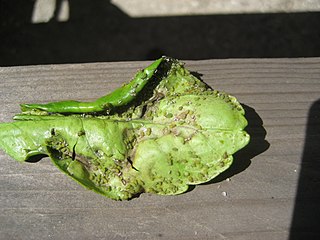Blight refers to a specific symptom affecting plants in response to infection by a pathogenic organism.

Australian limes are species of the plant genus Citrus that are native to Australia and Papua New Guinea.

Citrus production encompasses the production of citrus fruit, which are the highest-value fruit crop in terms of international trade. There are two main markets for citrus fruit:

A leaf spot is a limited, discoloured, diseased area of a leaf that is caused by fungal, bacterial or viral plant diseases, or by injuries from nematodes, insects, environmental factors, toxicity or herbicides. These discoloured spots or lesions often have a centre of necrosis. Symptoms can overlap across causal agents, however differing signs and symptoms of certain pathogens can lead to the diagnosis of the type of leaf spot disease. Prolonged wet and humid conditions promote leaf spot disease and most pathogens are spread by wind, splashing rain or irrigation that carry the disease to other leaves.

Black rot is a name used for various diseases of cultivated plants caused by fungi or bacteria, producing dark brown discoloration and decay in the leaves of fruit and vegetables:

Alternaria is a genus of Deuteromycetes fungi. All species are known as major plant pathogens. They are also common allergens in humans, growing indoors and causing hay fever or hypersensitivity reactions that sometimes lead to asthma. They are present in the human mycobiome and readily cause opportunistic infections in immunocompromised people such as AIDS patients.

Alternaria alternata is a fungus causing leaf spots, rots, and blights on many plant parts, and other diseases. It is an opportunistic pathogen on over 380 host species of plant.
Phytophthora citrophthora, also known as brown rot of citrus, is a soil borne oomycete that infects several economically important citrus crops. A diagnostic symptom of P. citrophthora is gummosis, wherein lesions around the base of the tree exude sap. Other common symptoms include dark longitudinal lesions forming at the soil line, a sour smell, and eventual cracking of the bark. Advanced symptoms include yellowing and necrosis of the tree canopy. Girdling action caused by the pathogen around the trunk can often cause the collapse of the tree. Resistant lemon varieties have been developed and their implementation has been effective at controlling the spread of the disease. Fruits that have been infected with P. citrophthora exhibit symptoms of brown rot characterized by a distinct odor. This disease is most active in the moderate temperatures of spring, fall, and winter months, opposite of most other Phytophthora species.

Alternaria brassicae is a plant pathogen able to infect most Brassica species including important crops such as broccoli, cabbage and oil seed rape. It causes damping off if infection occurs in younger plants and less severe leaf spot symptoms on infections of older plants.
Alternaria triticina is a fungal plant pathogen that causes leaf blight on wheat. A. triticina is responsible for the largest leaf blight issue in wheat and also causes disease in other major cereal grain crops. It was first identified in India in 1962 and still causes significant yield loss to wheat crops on the Indian subcontinent. The disease is caused by a fungal pathogen and causes necrotic leaf lesions and in severe cases shriveling of the leaves.
Alternaria citri is a fungal plant pathogen that causes black rot in citrus plants.
Alternaria dauci is a plant pathogen. The English name of the disease it incites is "carrot leaf blight".

Alternaria padwickii is a plant pathogen that attacks rice. It is associated with the disease stackburn, otherwise known as alternaria leaf spot.

Alternaria solani is a fungal pathogen that produces a disease in tomato and potato plants called early blight. The pathogen produces distinctive "bullseye" patterned leaf spots and can also cause stem lesions and fruit rot on tomato and tuber blight on potato. Despite the name "early," foliar symptoms usually occur on older leaves. If uncontrolled, early blight can cause significant yield reductions. Primary methods of controlling this disease include preventing long periods of wetness on leaf surfaces and applying fungicides. Early blight can also be caused by Alternaria tomatophila, which is more virulent on stems and leaves of tomato plants than Alternaria solani.
Alternaria dianthi, sometimes known as carnation blight, is a fungal pathogen of the genus Dianthus. Alternaria dianthi infections begin as small circular or ovular spots on leaves and stems, which can be red, purple, brown, yellow or gray.

Oncometopia is a genus of sharpshooters found in North and South America. The genus was erected by Carl Stål in 1869.

Trioza erytreae, the African citrus psyllid, is a sap-sucking insect, a hemipteran bug in the family Triozidae. It is an important pest of citrus, being one of only two known vectors of the serious citrus disease, huanglongbing or citrus greening disease. It is widely distributed in Africa. The other vector is the Asian citrus psyllid, Diaphorina citri.

The Murcott is a tangor, or mandarin–sweet orange hybrid.

Fludioxonil is a synthetic phenylpyrrole chemical introduced by Ciba-Geigy in 1993 for use as a non-systemic fungicide. It is a structural analog of the natural fungicide pyrrolnitrin.

Alternaria leaf spot or Alternaria leaf blight are a group of fungal diseases in plants, that have a variety of hosts. The diseases infects common garden plants, such as cabbage, and are caused by several closely related species of fungi. Some of these fungal species target specific plants, while others have been known to target plant families. One commercially relevant plant genus that can be affected by Alternaria Leaf Spot is Brassica, as the cosmetic issues caused by symptomatic lesions can lead to rejection of crops by distributors and buyers. When certain crops such as cauliflower and broccoli are infected, the heads deteriorate and there is a complete loss of marketability. Secondary soft-rotting organisms can infect stored cabbage that has been affected by Alternaria Leaf Spot by entering through symptomatic lesions. Alternaria Leaf Spot diseases that affect Brassica species are caused by the pathogens Alternaria brassicae and Alternaria brassicicola.













